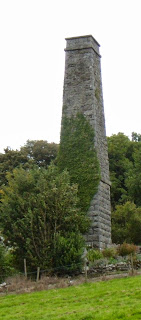I think we can now say with confidence that the Crag Foot chimney was linked with the 1840's pump that drained Leighton Moss.
Some accounts had suggested that the square-sided chimney was part of the old mine workings that pepper Warton Crag (see my earlier blog entry: 'A Tale of Two Chimneys')
But this weekend the County's Archaeology Adviser Peter Iles visited the site to compare old maps with the stone-work leading up to the base of the chimney.
 |
| Archaeologist Peter Iles at Crag Foot |
After the visit he told me:
"I was personally convinced that the chimney could have served the pumping station site, and that the documents that you have found within the archives strongly indicate that it was rebuilt under the supervision of Richard Gillow from an earlier chimney for this purpose. The earlier chimney was presumably associated with the mining of iron and copper in the area, but its precise function is unknown."
So the present chimney probably served the Moss pump but it replaced one that may have been linked to the mines. It's good to discover that no-one was entirely wrong!
The fact that the chimney was so far above the site of the engine house had initially persuaded Peter that the chimney was probably unrelated to the drainage of the Moss.

 "What we saw was a stone-built feature leading away from the chimney to the north, apparently constructed with limestone rubble walls and massive limestone capstones. It appeared to be hollow and thus most probably a flue serving the base of the chimney. It extended across the garden to Mill Cottage and in the adjacent plot seemed to be continued as a linear mound... At the lower end of this mound, as it proceeded north, it was lost within some garden landscaping, and could not be traced further. It was possible, however, that at this point it was able to turn more to the northwest around the end of Mill Cottage and head directly towards the site of the pumping station."
"What we saw was a stone-built feature leading away from the chimney to the north, apparently constructed with limestone rubble walls and massive limestone capstones. It appeared to be hollow and thus most probably a flue serving the base of the chimney. It extended across the garden to Mill Cottage and in the adjacent plot seemed to be continued as a linear mound... At the lower end of this mound, as it proceeded north, it was lost within some garden landscaping, and could not be traced further. It was possible, however, that at this point it was able to turn more to the northwest around the end of Mill Cottage and head directly towards the site of the pumping station." 






